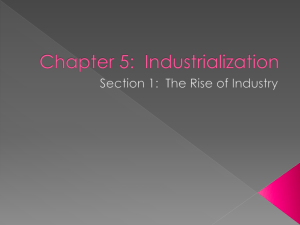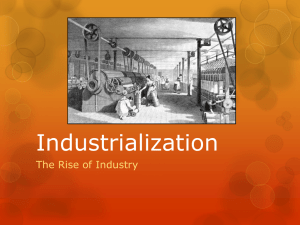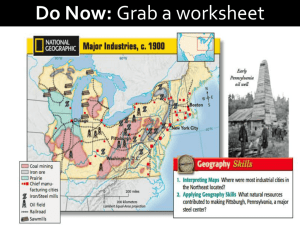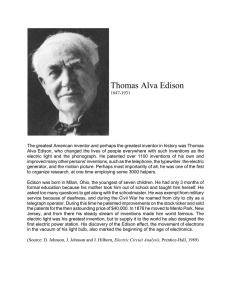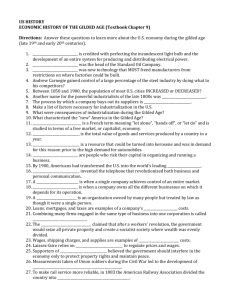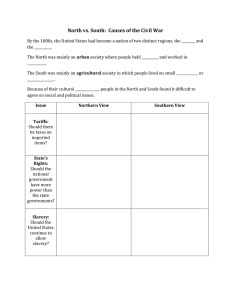Textbook Chapter on The Rise of Industry
advertisement
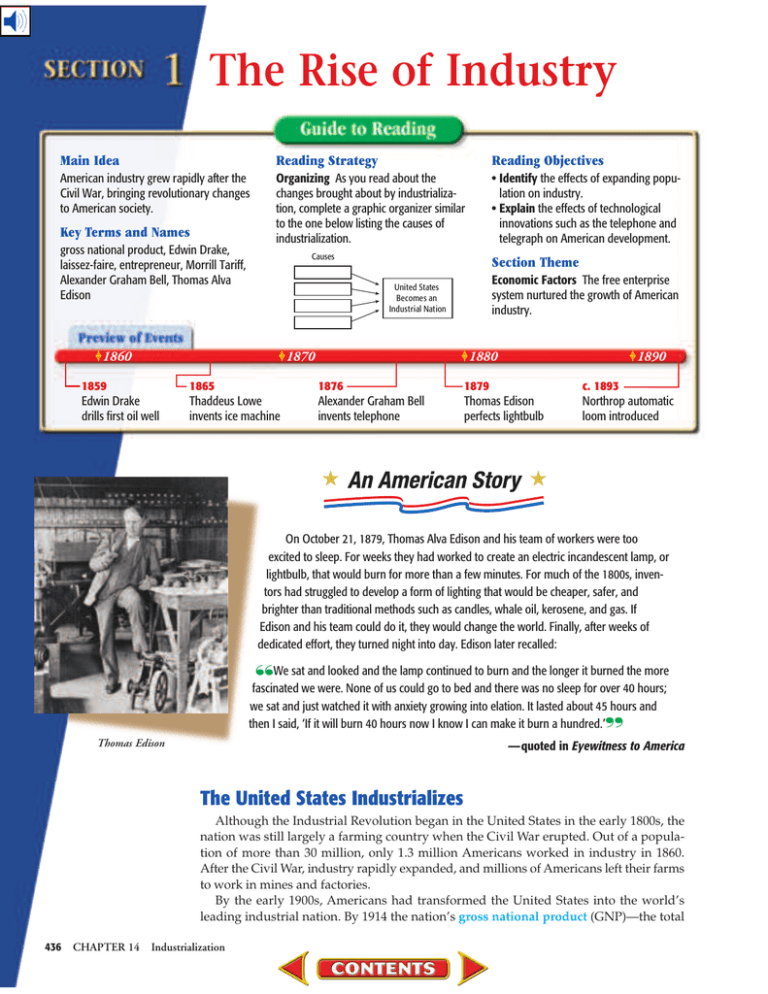
The Rise of Industry Main Idea Reading Strategy Reading Objectives American industry grew rapidly after the Civil War, bringing revolutionary changes to American society. Organizing As you read about the changes brought about by industrialization, complete a graphic organizer similar to the one below listing the causes of industrialization. • Identify the effects of expanding population on industry. • Explain the effects of technological innovations such as the telephone and telegraph on American development. Key Terms and Names gross national product, Edwin Drake, laissez-faire, entrepreneur, Morrill Tariff, Alexander Graham Bell, Thomas Alva Edison ✦1860 Causes Section Theme ✦1870 1859 Edwin Drake drills first oil well Economic Factors The free enterprise system nurtured the growth of American industry. United States Becomes an Industrial Nation 1865 Thaddeus Lowe invents ice machine ✦1880 1876 Alexander Graham Bell invents telephone ✦1890 1879 Thomas Edison perfects lightbulb c. 1893 Northrop automatic loom introduced On October 21, 1879, Thomas Alva Edison and his team of workers were too excited to sleep. For weeks they had worked to create an electric incandescent lamp, or lightbulb, that would burn for more than a few minutes. For much of the 1800s, inventors had struggled to develop a form of lighting that would be cheaper, safer, and brighter than traditional methods such as candles, whale oil, kerosene, and gas. If Edison and his team could do it, they would change the world. Finally, after weeks of dedicated effort, they turned night into day. Edison later recalled: We sat and looked and the lamp continued to burn and the longer it burned the more “ fascinated we were. None of us could go to bed and there was no sleep for over 40 hours; we sat and just watched it with anxiety growing into elation. It lasted about 45 hours and then I said, ‘If it will burn 40 hours now I know I can make it burn a hundred.’ ” Thomas Edison —quoted in Eyewitness to America The United States Industrializes Although the Industrial Revolution began in the United States in the early 1800s, the nation was still largely a farming country when the Civil War erupted. Out of a population of more than 30 million, only 1.3 million Americans worked in industry in 1860. After the Civil War, industry rapidly expanded, and millions of Americans left their farms to work in mines and factories. By the early 1900s, Americans had transformed the United States into the world’s leading industrial nation. By 1914 the nation’s gross national product (GNP)—the total 436 CHAPTER 14 Industrialization value of all goods and services produced by a country—was eight times greater than it had been when the Civil War ended. Natural Resources An abundance of raw materials was one reason for the nation’s industrial success. The United States contained vast natural resources upon which industry in the 1800s depended, including water, timber, coal, iron, and copper. The presence of these resources meant that American companies could obtain them cheaply and did not have to import them from other countries. Many of the nation’s resources were located in the mountains of the American West. The settlement of this region after the Civil War helped to accelerate industrialization, as did the construction of the transcontinental railroad. Railroads brought settlers and miners to the region, and carried the resources back to factories in the East. At the same time, a new resource, petroleum, began to be exploited. Even before the invention of the automobile, petroleum was in high demand because it could be turned into kerosene. Kerosene was used in lanterns and stoves. The American oil industry was built on the demand for kerosene. It began in western Pennsylvania, where residents had long noticed oil bubbling to the surface of area springs and streams. In 1859 Edwin Drake drilled the first oil well near Titusville, Pennsylvania. By 1900 oil fields from Pennsylvania to Texas had been opened. As oil production rose, it fueled economic expansion. A Large Workforce The human resources available to American industry were as important as natural resources in enabling the nation to industrialize rapidly. Between 1860 and 1910, the population of the United States almost tripled. This population provided industry with a large workforce and also created greater demand for the consumer goods that factories produced. Population growth stemmed from two causes— large families and a flood of immigrants. American industry began to grow at a time when social and economic conditions in China and eastern Europe convinced many people to leave their nations and move to the United States in search of a better life. Between 1870 and 1910, roughly 20 million immigrants arrived in the United States. These multitudes added to the growing industrial workforce, helping factories increase their production and furthering demand for industrial products. Reading Check Explaining How did oil production affect the American economy? Major Industries, c. 1900 90°W 80°W Early Pennsylvania oil well N E W Boston S Chicago New York City 40°N Pittsburgh Washington, D.C. Coal mining Iron ore Prairie Chief manufacturing cities Iron/Steel mills Oil field Railroad Sawmills 0 200 miles 200 kilometers 0 Lambert Equal-Area projection 1. Interpreting Maps Where were most industrial cities in the Northeast located? 2. Applying Geography Skills What natural resources contributed to making Pittsburgh, Pennsylvania, a major steel center? CHAPTER 14 Industrialization 437 1876 Alexander Graham Bell, telephone American Inventions 1865 Thaddeus Lowe, ice machine ✦1850 ✦1865 1852 Elisha Otis, elevator brake 1864 George Pullman, rail sleeping car Free Enterprise Another important factor that enabled the United States to industrialize rapidly was the free enterprise system. In the late 1800s, many Americans embraced the idea of laissez-faire (leh·say·FAR), literally “let do,” a French phrase meaning “let people do as they choose.” Supporters of laissez-faire believe the government should not interfere in the economy other than to protect private property rights and maintain peace. These supporters argue that if the government regulates the economy, it increases costs and eventually hurts society more than it helps. Laissez-faire relies on supply and demand rather than the government to regulate prices and wages. Supporters claim that a free market with competing companies leads to greater efficiency and creates more wealth for everyone. Laissez-faire advocates also support low taxes to ensure that private individuals, not the government, will make most of the decisions about how the nation’s wealth is spent. They also believe that the government’s debt should be kept limited since money the government borrows from banks is not available to be loaned to individuals for their own uses. In the United States, the profit motive attracted people of high ability and ambition into business. American entrepreneurs—people who risk their capital in organizing and running a business—appreciated the challenges and rewards of building a business and making profits for themselves. In the late 1800s, the prospect of making money in manufacturing and transportation attracted many entrepreneurs. The savings that New Englanders accumulated through trade, fishing, whaling, textile mills, and shoe manufacturing helped build hundreds 438 CHAPTER 14 Industrialization 1874 Stephen Dudley Field, electric streetcar of factories and thousands of miles of railroad track. An equally important source of private capital was Europe, especially Great Britain. Foreign investors saw more opportunity for profit and growth in the United States than at home, and their money also helped to fund the nation’s industrial buildup. Reading Check Explaining What does it mean when a government has a laissez-faire economic policy? Government’s Role in Industrialism In many respects, the United States practiced laissez-faire economics in the late 1800s. State and federal governments kept taxes and spending low and did not impose costly regulations on industry. Nor did they try to control wages and prices. In other ways, the government went beyond laissez-faire and adopted policies intended to help industry, although these policies frequently produced results other than what had been intended. Since the early 1800s, the struggle between the northeastern states and the southern states had shaped the economic debate in the United States. Northern leaders wanted high tariffs to protect American industry from foreign competition. They also sought federal subsidies for companies building roads, canals, and railroads to the west. Southern leaders opposed subsidizing internal improvements, and they favored low tariffs to promote trade and to keep the cost of imported manufactured goods low. The Civil War ended this debate. When the South seceded, the Republicans were left in control of Congress. They quickly passed the Morrill Tariff, 1877 Thomas Edison, phonograph 1893 Charles and J. Frank Duryea, gasoline-powered car 1887 Granville T. Woods, electromechanical brake ✦1880 1879 Thomas Edison, incandescent lightbulb 1879 James Ritty, cash register ✦1895 1883 Jan E. Matzeliger, shoemaking machine reversing years of declining tariffs. By the end of the Civil War, tariffs had nearly tripled. Congress also gave vast tracts of western land and nearly $65 million in loans to western railroads. The government also sold public lands with mineral resources for much less than their market value. Historians still dispute whether these policies helped to industrialize the country. Supporters of laissez-faire generally favor free trade and oppose subsidies, believing that tariffs and subsidies drive up prices and protect inefficient companies. They point out that one reason the United States industrialized so rapidly in the 1800s was because it was one of the largest free trade areas in the world. Unlike Europe, which was divided into dozens of states, each with tariffs, the entire United States was open to trade. The Constitution bans states from imposing tariffs, and there were few federal regulations to impede the movement of goods across the country. Similarly, the United States practiced free trade in labor, placing very few restrictions on immigration. High tariffs, however, contradicted laissez-faire ideas and hurt many Americans. When the United States raised tariffs against foreign goods, other countries raised their tariffs against American goods. This hurt American companies trying to sell goods overseas, and in particular, it hurt farmers who sold their products to Europe. Ironically, the problems farmers faced may have helped speed up industrialization, as many rural Americans decided to leave their farms and take jobs in the new factories. Despite the problems tariffs created for trade, many business leaders and members of Congress believed they were necessary. Much of Western Europe had already industrialized, and few believed that the new American industries could compete with the large established European factories unless tariffs were put in place to protect them. By the early 1900s, many American industries were large and highly competitive. Business leaders increasingly began to push for free trade because they believed they could compete internationally and win. Reading Check Analyzing Do you think government policies at this time helped or hindered industrialization? Why? New Inventions A flood of important inventions helped increase the nation’s productive capacity and improved the network of transportation and communications that was vital to the nation’s industrial growth. New inventions led to the founding of new corporations, which produced new wealth and new jobs. TECHNOLOGY Bell and the Telephone One of the most dramatic inventions in the late 1800s came in the field of communications. In 1874 a young Scottish-American inventor named Alexander Graham Bell suggested the idea of a telephone to his assistant, Thomas Watson. Watson recalled, “He had an idea by which he believed it would be possible to talk by telegraph.” Bell intended to make an electrical current of varying intensity transmit sound. Bell worked until 1876 before he succeeded in transmitting his voice. Picking up the crude telephone, he called to the next room, “Come here, Watson, I want you.” Watson heard and came. The telephone CHAPTER 14 Industrialization 439 revolutionized both business and personal communication. In 1877 Bell and others organized the Bell Telephone Company, which eventually became the American Telephone and Telegraph Company (AT&T). Edison and Electricity Perhaps the most famous inventor of the late 1800s was Thomas Alva Edison. His laboratory at Menlo Park, New Jersey, staffed by skilled assistants, became the forerunner of the modern research laboratory. Edison stood as a symbol for the emerging age of technology. Edison first achieved international fame in 1877 with the invention of the phonograph. Two years later, he perfected the lightbulb and the electric generator. His laboratory then went on to invent or improve several other major devices, including the battery, the dictaphone, and the motion picture. In 1882 an Edison company began to transform American society when it started supplying electric power to New York City customers. In 1889 several Edison companies merged to form the Edison General Electric Company, which today is known as GE. Technology’s Impact As knowledge about technology grew, almost everyone in the United States felt its effects. Shortly after the Civil War, Thaddeus Lowe invented the ice machine, the basis of the refrigerator. In the early 1870s, Gustavus Swift hired an engineer to develop a refrigerated railroad car. In 1877 Swift shipped the first refrigerated load of fresh meat. The widespread use of refrigeration kept food fresh longer and reduced the risk of food poisoning. Checking for Understanding 1. Define: gross national product, laissezfaire, entrepreneur. 2. Identify: Edwin Drake, Morrill Tariff, Alexander Graham Bell, Thomas Alva Edison. 3. Explain how an abundance of natural resources contributed to economic growth in the United States in the late 1800s. Reviewing Themes 4. Economic Factors How did the principles of the free enterprise system, laissez-faire, and profit motive encourage the rise of industry? 440 CHAPTER 14 Industrialization The textile industry had long depended on machines to turn fibers into cloth. By the mid-1800s, the introduction of the Northrop automatic loom allowed cloth to be made at an even faster rate. Bobbins, which previously had been changed by hand, were now changed automatically without stopping the loom. Great changes also took place in the clothing industry. Standard sizes, developed from measurements taken of Union soldiers during the Civil War, were used in the manufacture of ready-made clothes. Power-driven sewing machines and cloth cutters rapidly moved the clothing business from small tailor shops to large factories. Similar changes took place in shoemaking. Large factories began using new processes and inventions to mass-produce shoes. They could make shoes more efficiently than cobblers and sell them for lower prices. By 1900 local cobblers had nearly disappeared. Prices of many other products also dropped as the United States industrialized. Technology’s impact also included improved connections among people. In 1866 Cyrus Field laid a telegraph cable across the Atlantic Ocean. This transatlantic cable provided instant contact between the United States and Europe. Another innovation was the radio. By the 1920s, radios had become common in American homes, and radio stations sprang up throughout the United States. Reading Check Explaining How did the use of electric power affect the economic development of the United States? Critical Thinking 5. Synthesizing What role did the federal government play in increasing industrialization in the United States after the Civil War? 6. Organizing Use a graphic organizer similar to the one below to indicate how the inventions listed affected the nature of American work and business. Invention telephone lightbulb automatic loom Effects Analyzing Visuals 7. Applying Time Lines Copy the time line on pages 438 and 439 onto a separate sheet of paper. Add other inventions you have learned about to the time line in proper chronological order. Be sure to include the date for each invention. Writing About History 8. Descriptive Writing Imagine you are a young person living in this country in the late 1800s. Choose one of the inventions discussed in the section, and write a journal entry describing its impact on your life. Use standard grammar, spelling, sentence structure, and punctuation.
